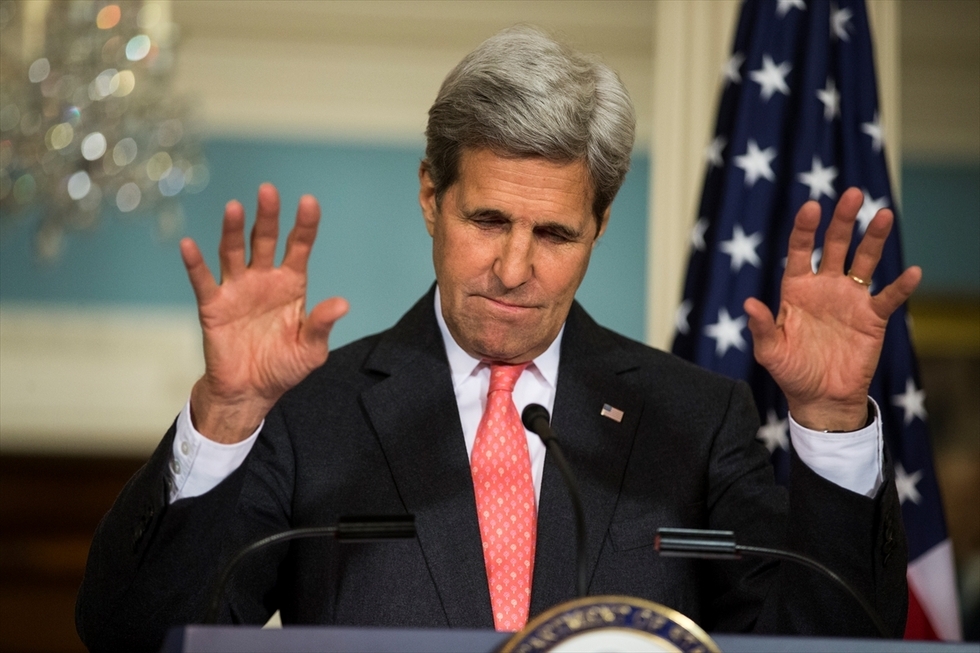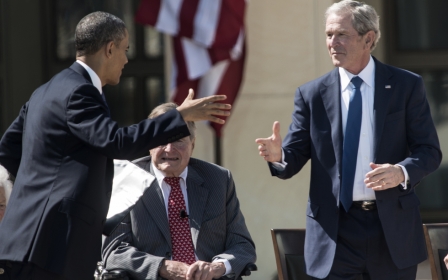'Plan B' and the bankruptcy of US Syria policy

US Secretary of State John Kerry provoked widespread speculation when he referred in testimony before the Senate foreign relations committee last week to “significant discussions” within US President Barack Obama's administration about a “Plan B” in Syria. The speculation was further stoked by a “senior official” who told CBS News that options under consideration included "'military-like' measures that would make it harder for the regime and its allies to continue their assault on civilians and US-backed rebels.”
But “Plan B” is more complicated than that. A report by CNN’s Pentagon correspondent Barbara Starr on 26 February leaves little room for doubt that the administration’s cupboard of policy options is actually bare. An unnamed “senior US official” at the Pentagon admitted that “Plan B” is actually “more an idea than a specific course of action”. In other words, the administration’s national security policymakers believe something more should be done in Syria, but they are not at all clear what could be done now.
The official said three options were under discussion, none of which is even close to being realistic in the present situation: an increase in US Special Forces on the ground, an increase in arms assistance to fighters opposing Syrian President Bashar al-Assad, and a no-fly zone.
The option of adding more Special Forces is only relevant to a counter-terrorism strategy aimed at the Islamic State (IS) group, not at preventing the further weakening of anti-Assad forces. Special Forces are now in Syria to help the one reliable ally against IS – the Kurdish YPG. Sending them into provinces to fight the Syrian army or Hezbollah wouId be an overreach of stunning proportions.
Increasing arms to opposition forces is not feasible as long as the Russians are able to cut the line of supply from Turkey to Aleppo – unless the US is prepared to go to war with Russia by trying to airdrop the weapons, which would involve direct military conflict with the Russian Air Force.
As for the no-fly zone option, which Turkey and Saudi Arabia have pressed on Obama for years without success, the senior official made it clear to CNN that the Pentagon still opposes that option - as it has since early 2012 when it was first proposed. It is even less viable, according to the official, because it would have to destroy Russian air defence radars rather than just Syrian air defences.
“I can’t tell you that’s off the table,” said the official. “It’s at the end of the table, just not off it.” Translation: someone may still be advocating it, but it is not going to be adopted.
Kerry’s invocation of “Plan B”, on the other hand, was an effort to suggest that there is a serious possibility of a more aggressive US posture in Syria and that he was personally behind such a move. Just before his reference to “Plan B” in the testimony, Kerry took the unusual step of declaring, “It is well known that I have advocated strong efforts to support the opposition.” And he suggested that “Plan B”, if there was one, would be more “confrontational”. But he also acknowledged that there would be many stages before anything dramatically different would be done, and that it would only come when it became clear that there was no way to save the negotiating process.
At the same time that Kerry sent signals that conflict with those of the Pentagon, he was also trying to fend off attacks on his ceasefire and negotiation strategy by Republicans who asserted that the Russians and the Assad government have already essentially won the war against the opposition.
Ever since it became clear that the Russian air offensive in Aleppo and Idlib has been successful in loosening the grip of al-Nusra Front and its “moderate” allies along the route from Aleppo to the Turkish border, the political elite in Washington has been buzzing about what the Washington Post diplomatic correspondent has called the “appearance of allowing Russia to act with impunity” in Syria.
Such language, implying that the United States should be taking action to counter the Russian-Syrian offensive, reflects the distorted image of the Syrian conflict in US political discourse.
The Obama administration helped create that distortion by putting forward the fiction of a powerful “moderate” military force in Syria that could be the basis for a negotiated settlement. The premise of the administration’s argument claims that Russian planes had mainly targeted US-supported “moderate” forces, who the Russians called “terrorists”.
In fact, the Obama administration had been well aware since early 2013 that al-Qaeda’s affiliate al-Nusra Front and its Salafist allies, supported by US regional allies, were already beginning to dominate the secular, pro-democratic forces.
Kerry was well aware in 2015 that the opposition groups in Idlib and Aleppo provinces - to which the United States had been supplying weapons - had not only been coordinating their military operations with al-Nusra, but actually intermingled with them throughout those provinces. Kerry had depended on the power of Salafist forces to gain some leverage on the Syrian government in negotiations.
That unacknowledged Obama administration strategy explains why Kerry tried to get Russian Foreign Minister Sergei Lavrov to agree that al-Nusra would not be targeted under the ground rules of the ceasefire “at least temporarily until the groups can be sorted out”, according to the Washington Post. But after Russia rejected that bid, Kerry switched signals, and Syria stories began to refer to US-supported forces that operated in close conjunction with al-Nusra. And on 22 February, State Department spokesman, Mark Toner, even acknowledged publicly the “commingling” of the two supposedly independent moderates with the Salafists. Apparently Kerry had concluded that he was better off explaining why the rules of the ceasefire were a response to facts on the ground rather than a US concession to the Russians.
Kerry suggested that the US was still a player in the Syrian contest for power. Regarding foreign relations committee chairman Bob Corker’s comment that the Russians had been “accomplishing their ends” in Syria, he argued that the Russians and the Syrian government could take control of Aleppo, but that “holding territory has always been difficult”. Kerry claimed that the Russians could not prevent the opposition from getting the weapons needed to continue the war, as long as the US and its allies were supporting them. He offered no explanation for that claim.
The “Plan B” episode illuminates another moment in the pattern of failed US policymaking on the Syrian crisis. It reveals a familiar pattern of deep division over Syria in which key players seek to advance their own personal or institutional interests and in which the desire to maintain a US leadership role trumps the realities of the situation on the ground in Syria. If the US policy were a company doing business in Syria, it would have been bankrupt years ago.
- Gareth Porter is an independent investigative journalist and winner of the 2012 Gellhorn Prize for journalism. He is the author of the newly published Manufactured Crisis: The Untold Story of the Iran Nuclear Scare.
The views expressed in this article belong to the author and do not necessarily reflect the editorial policy of Middle East Eye.
Photo: US Secretary of State John Kerry speaks during a press conference at the Department of State in Washington, USA on 29 February, 2016 (AA).
New MEE newsletter: Jerusalem Dispatch
Sign up to get the latest insights and analysis on Israel-Palestine, alongside Turkey Unpacked and other MEE newsletters
Middle East Eye delivers independent and unrivalled coverage and analysis of the Middle East, North Africa and beyond. To learn more about republishing this content and the associated fees, please fill out this form. More about MEE can be found here.





